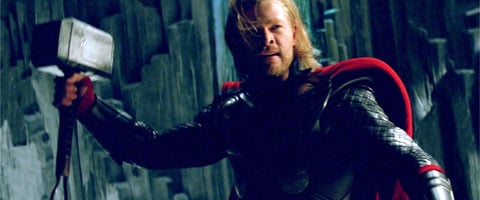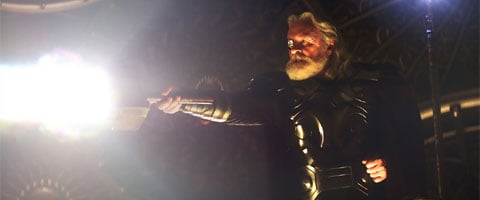To 3D Or Not To 3D: Choose The Right Thor Ticket

When you show up to see Thor this weekend the biggest decision you'll face isn't when to see it, but how to see it. Marvel's new superhero tentpole is being released in 3D and if you're lucky, should be playing in 2D somewhere nearby as well. 3D ticket prices continue to rise, which means if you see it in 3D you could be paying as much as $30 a ticket in some places. We're here to help you figure out if it's worth the price.
Our “To 3D or Not to 3D” series does not analyze the relative merits of a movie like Thor as a piece art or entertainment. If you're interested in a review of Thor, just click the review button on our menu. Instead what I'll give you here is an unbiased analysis of the film's 3D on a technical level. To make that easy to digest, we break Thor's 3D down into a simple, 7-point rating system to help you determine whether to see Thor in 2D or 3D. Read on as we wield the power of Thor…

Does It Fit?
3D only really makes sense as a format on special effects driven action movies and it works better on computer generated images than it does on live action elements. Thor is obviously an FX action movie, and since a lot of it takes place in fantastical locations a lot of the imagery you'll see on screen is entirely computer animated. In theory that makes it a solid candidate for the 3D format, though the film does contain many entirely live action locations which don't really seem to need 3D at all.
Fit Score: 3/5

Planning & Effort
Marvel didn't decide it wanted all of its upcoming movies to be in 3D until after Thor had already been filmed. So Thor is an after the fact post-conversion. It wasn't shot in 3D. Post-conversion can work nearly as well as shooting in 3D, if the film was at least filmed with an eye towards converting it to 3D later, but that didn't happen with Thor. Director Kenneth Branaugh made his movie, then someone said, “hey this has to be in 3D”, and so they went to work trying to force what they'd already done into the format. The good news is that Marvel made their decision some time around November of last year, so they had plenty of time to work on it, but the fact that the movie wasn't originally created to be a 3D film is a big mark against it.
Planning & Effort Score: 2/5

Beyond the Window
Your Daily Blend of Entertainment News
Done right 3D can be used to give the illusion of depth. It creates the feeling that instead of looking at a picture projected on a flat surface, you're looking through a window into another world which exists just out of your reach on the other side of the screen. Thor does that, with mixed results. It looks great in the film's more fantastical sequences, which take place in the outerspacey Asgard, populated by gods and crazy spires surrounded by the stars of the heavens. When Thor comes down to earth though, so does the movie's 3D and far too often the images on the screen end up looking like paper cutouts, standing in some sort of shoe box. It's the same problem that M. Night Shyamalan's Last Airbender 3D conversion had, to a much greater degree. Here it's far less distracting, and it's not always a problem, but it's hard to call this conversion a success when it only occasionally seems to know how to create proper depth.
Beyond The Window Score: 2/5

Before the Window
3D isn't limited to simply providing picture depth. Done right 3D can make it seem as though objects in the movie are actually out in front of the “window” or the box outline of the screen or even make it seem like things are flying over your head. Done wrong this can become a gimmick, but done properly it can actually be an incredibly useful storytelling device. Unfortunately Thor doesn't even try. This is to be expected, since it wasn't planned as a 3D movie from the start, so director Kenneth Branaugh really couldn't structure his shots to take full advantage of the format. In light of that, I suppose the film deserves at least some credit for not trying to pull it off anyway, when it really wasn't set up to do it. I guess it's better to have nothing than to have something bad. Still, it's not like you'll get a discount on your movie ticket because they're only using half of the possible 3D effects. You'll still pay the full 3D price.
Before The Window Score: 2/5

Brightness
When you put on a pair of 3D glasses, you're basically putting a filter between yourself and the screen. It's like wearing sunglasses in a movie theater. There are ways to compensate for this using the theater's projector, but many theaters don't bother, and most good 3D movies find ways to compensate for this on their own. Ideally 3D should only be used on movies containing bright, sharply defined pictures and Thor is exactly that kind of film. Even with those filters in front of your eyes blocking out some of the visible light emissions, Thor remains bright, vibrant, and lively to look at throughout. It probably helps that portions of the film, like the Asgard sequences, are largely computer generated. But even live action scenes on Earth look consistently vibrant.
Brightness Score: 5/5

The Glasses Off Test
Take off your 3D glasses while you're watching a good 3D movie, and the picture in front of you will become a blur. The best way to explain this is that the blurrier the image is without your glasses on, the more fully utilized most of the 3D on screen will be. To test that I took my glasses off periodically throughout Thor, and unfortunately only noticed a minimal difference. Really great 3D movies vary the depth of the picture, depending on what's happening on screen. So at times the picture separation becomes greater than at others. But I never noticed any difference in the depth of 3D effects being used. In truth, the actual blurring without my glasses was fairly minimal. Thor is being projected in 3D, but not all that much 3D. It doesn't seem committed to it, except as something to put on the marquee in order to justify charging more for tickets.
Glasses Off Score: 1/5

Audience Health
Badly implemented 3D can cause headaches, dizziness, and nausea in even the most hardy moviegoers. The good and bad news when it comes to Thor is that because it doesn't really seem all that committed to wowing anyone with its 3D effects, it's not really going to do anything to make you sick either. Headaches aren't likely to be a problem, since those are most often caused by the eyestrain of looking at dim 3D images and Thor, though it doesn't really get anything else about 3D right, is projected in a way that's bright and vibrant on screen. Bottom line here, you may not enjoy the 3D but at least it's not going to make you sick.
Health Score: 5/5
| SCORES RECAP | |
| 3D Fit | 3 |
| Planning and Effort | 2 |
| Beyond The Window | 2 |
| Before The Window | 2 |
| Brightness | 5 |
| The Glasses Off Test | 1 |
| Audience Health | 5 |
| Total Score | 20 (out of a possible 35) |
This poll is no longer available.
Final Verdict: It seems clear that Thor has only been converted into 3D as a cynical cash grab, a blatant move to charge higher prices for movie tickets. That said, should you see it in 3D, as long as you don't care about paying those higher ticket prices you won't exactly be disappointed. You just won't be impressed either. If you see it in 2D though, you're seeing Thor the way it was meant to be seen, and this beautifully shot movie is only going to look even better. With that in mind, if 2D showings of Thor aren't available in your area, I recommend making your own De-3D Glasses. It'll only make the movie better.
For more 3D analysis, visit our To 3D Or Not To 3D archive right here.

